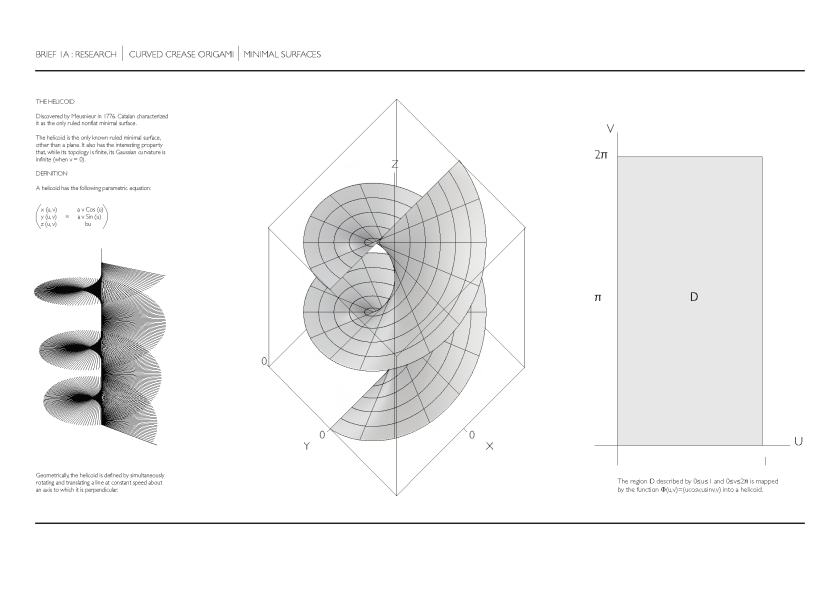Spiral Pleat Origami
The first part of the research focused on the pattern, folds and strips of a spiral pleat origami. A strip of rectangles or trapeziums is divided by equally spaced mountain folds,then sloping parallel valley folds are placed diagonally between the mountains to connect them. The complete pattern of folds can be drawn in one continuos zigzag line. Collapsed flat, it will resemble a circular rosette. It can also be made from shapes other than a rectangular strip, such as a very long triangle or a very long rhombus. The Helicoid
The Helicoid
Discovered by Meusnieur in 1776. The helicoid is the only known ruled minimal surface,nother than a plane. It also has the interesting property that, while its topology is finite, its Gaussian curvature is infinite (when v = 0).
Definition
A helicoid has the following parametric equation:
x (u, v) a v Cos (u)
y (u, v) = a v Sin (u)
z (u, v) bu
Geometrically, the helicoid is defined by simultaneously rotating and translating a line at constant speed about an axis to which it is perpendicular.  A parametrized helicoid. The function (u,v)=(ucosv,usinv,v) parametrizes a helicoid when (u,v) E D, where D is the rectangle [0,1]Å~[0,2]. The region D, shown as the rectangle in the first panel. The region D is divided into small rectangles which are mapped to “curvy rectangles” on the surface. You can click any of the borders of the small rectangles to highlight a curve where one of the variables is constant. Vertical lines in the rectangle D represent curves where u is constant; these correspond to curves that spiral up the helicoid. Horizontal lines in the rectangle D represent curves where v is constant; these correspond to lines that cut across the helicoid.
A parametrized helicoid. The function (u,v)=(ucosv,usinv,v) parametrizes a helicoid when (u,v) E D, where D is the rectangle [0,1]Å~[0,2]. The region D, shown as the rectangle in the first panel. The region D is divided into small rectangles which are mapped to “curvy rectangles” on the surface. You can click any of the borders of the small rectangles to highlight a curve where one of the variables is constant. Vertical lines in the rectangle D represent curves where u is constant; these correspond to curves that spiral up the helicoid. Horizontal lines in the rectangle D represent curves where v is constant; these correspond to lines that cut across the helicoid.
 The research into helicoid surfaces led to experiments with Curved Crease Origami. Experiments were done by cutting different shaped components out of the folded helicoid and connecting them together.
The research into helicoid surfaces led to experiments with Curved Crease Origami. Experiments were done by cutting different shaped components out of the folded helicoid and connecting them together.







 Physical model
Physical model
The structure is made out of six identical modules creating a volume. Each module consist of 14 arch-shaped strips that are laser cut and fixed together by attaching each strip on to a piece of fabric. This technique allows the surface to be folded in mountain and valley folds, where by introducing concentric folds to a flat surface allows the surface to bend freely and flexibly. Each module is placed in a circular pattern and laced together with string at each ends. Once attached, every second connection point is tied together towards the centre.
